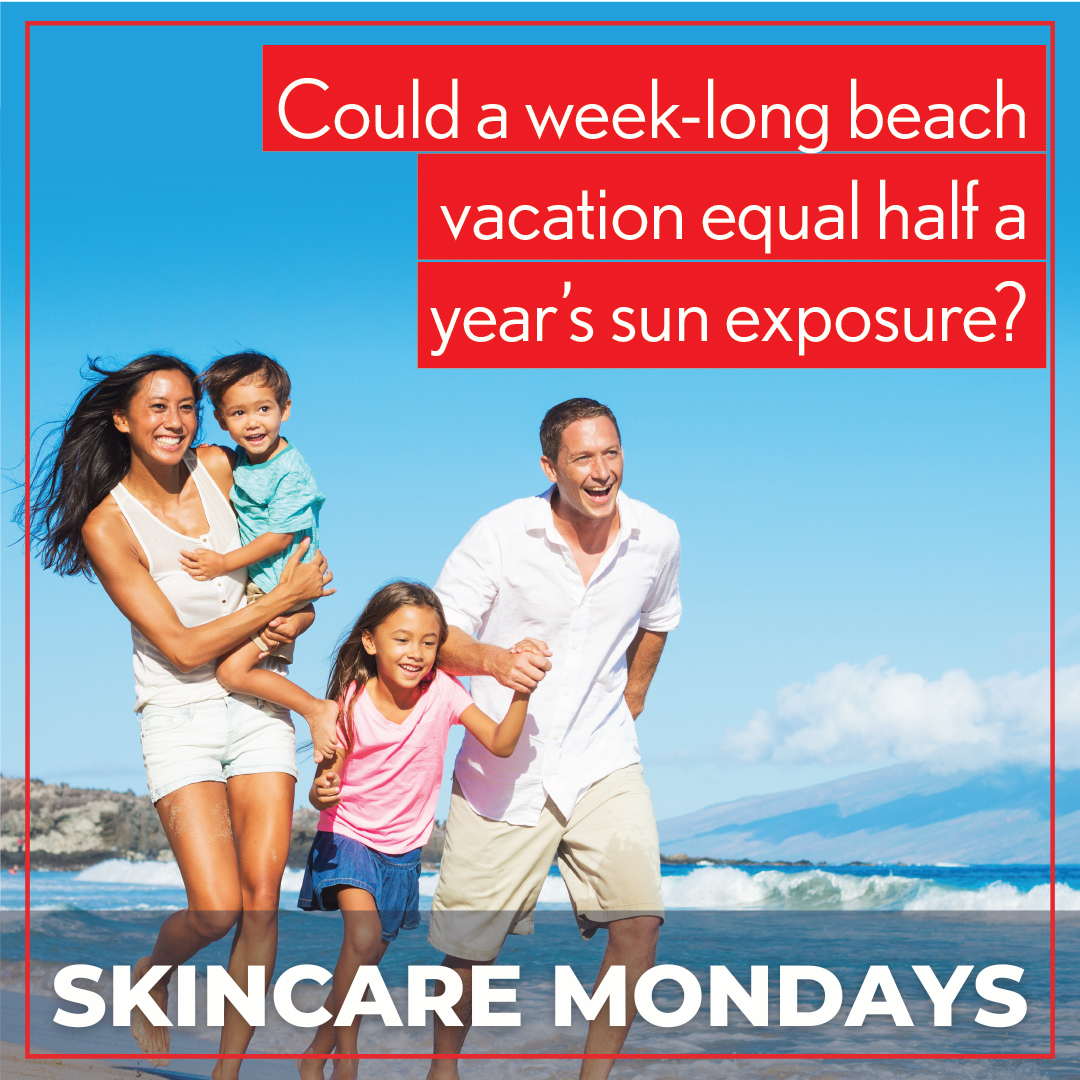Could a week-long beach vacation equal half a year’s sun exposure?
Americans make more than 400 million visits to the beach every year.1
-
- Studies show UV exposure during vacations makes up to 50% of an individual’s total annual UV exposure.2-6
- High-solar-intensity beach settings put patients at risk of UV over-exposure that can lead to acute and chronic health consequences including erythema, photoaging, and skin cancer.2,7
New 3D Modelling Study Shows Impact of Recreational UV Exposure,8
Accepted to the Journal of Photochemical & Photobiological Sciences
Most existing studies of solar exposure either extrapolate UV exposure from behavioral and location information acquired from surveys or personal subject diaries, or quantitatively measure personal UV exposure directly from worn dosimeters.
In this study, a radiative transfer model of the solar conditions of Tampa Bay, St. Petersburg, Florida in April was combined with a high-resolution 3D in-silico body model of an adult female figure utilized to calculate and visualize UV exposure doses at different body sites across a diverse assortment of settings and behaviors typical of a week-long beach vacation.

The resulting cumulative UV exposure calculated for a typical mix of clothing choices, settings and activities during a 7 day beach vacation is 172 standard erythemal doses (SED) which is comparable to the average total annual exposure of European and North American residents.
A full day spent exclusively at the beach or pool can yield up to 50 SED at multiple body sites.
Results:
All body sites are vulnerable to high UV doses in the beach/pool setting
Even when largely shaded by structures like an umbrella that reduce direct solar irradiance, diffuse irradiance from the unobscured sky and surrounding surfaces still resulted in significant UV exposure.
Clothing choices were the biggest determinant in significantly reducing UV exposure.
-
- Highest daily erythemal exposure totals are observed at body sites infrequently covered by clothing (head, neck, upper arm, forearms, hands, shin/calf, and feet)
- Head, chest, shoulders, and feet have highest exposures at the beach/pool
- Shade does not completely reduce sunburn risk, varying greatly depending on the shade source and body site.
- All sunny beach vacation settings (beach/pool, city/town, shaded balcony) contribute significantly to daily exposure totals.
Insights on Health Impacts of Recreational UV Exposure
-
- A full day in the beach/pool setting can result in 50 Standard Erythemal Dose(SED)/day of UV exposure and related sunburn risk
- Equivalent to 50x minimal erythemal dose in lightest skin tones (Fitzpatrick Skin Phototype 1)
- Equivalent to 4x minimal erythemal dose in darkest skin tones (Fitzpatrick Skin Phototype IV)
- The calculated erythemal exposure at the forearm for a week of Florida beach vacation is 172.2 SED – comparable to reported annual average dose of 173 SED in Denmark, Alaska and parts of Canada and more than half the annual average dose of 280 SED in Los Angeles and Atlanta.
- A 50% to 100% increase of annual UV exposure attributable to an additional single week-long Florida beach vacation for a typical North American resident may increase non-melanoma skin cancer (NMSC) risk by a factor of 2–4 for body sites with relatively high typical exposure.
- A full day in the beach/pool setting can result in 50 Standard Erythemal Dose(SED)/day of UV exposure and related sunburn risk
Conclusion:
Week-long beach vacations, while comprising only a small fraction of how a person spends their time annually, can contribute very significantly to a person’s cumulative annual UV exposure.
It is well established that UV light is a complete carcinogen and that excessive and chronic exposure can have detrimental effects on skin and by extension overall health. This work brings to light body sites that are particularly vulnerable to excessive UV exposure during various beach vacation activities, and the role behaviors such as clothing choice can have in mitigating exposure.

References:
-
- United States Lifesaving Association, 2019 national lifesaving statistics, 2021, http://arc.usla.org/Statistics/current.asp (last accessed June 2022).
- Calzavara-Pinton, R. Sala, M.C. Arisi, C. Bussoletti, L. Celleno, Photobiology, photodermatology and sunscreens: A comprehensive overview. Part 1: Damage from acute and chronic solar exposure, G. Ital. Dermatol. Venereol. 148 (2013) 89-106.
- Schauberger, G. Keck, A. Cabaj, Trend analysis of solar ultraviolet exposure of the Austrian population caused by holiday patterns since 1969, Photodermatol. Photoimmunol. Photoreed. 9 (1992) 72-77.
- Thieden, P.A. Philipsen, J. Heydenreich, H.C. Wulf, UV radiation exposure related to age, sex, occupation, and sun behavior based on time-stamped personal dosimeter readings, Arch. Dermatol. 140 (2004) 197-203.
- Petersen, E. Thieden, P.A. Philipsen, J. Heydenreich, H.C. Wulf, A.R. Young, Determinants of personal ultraviolet-radiation exposure doses on a sun holiday, Br. J. Dermatol. 168 (2013) 1073-1079.
- E. Godar, S.P. Wengraitis, J. Shreffler, D.H. Sliney, UV doses of Americans, Photochem. Photobiol. 73 (2001) 621-629.
- Office of the Surgeon General, The Surgeon General’s call to action to prevent skin cancer, U.S. Department of Health and Human Services, Bethesda, MD, 2014, https://www.hhs.gov/sites/default/files/call-to-action-prevent-skin-cancer.pdf (last accessed June 2022).
- Modeling Acute and Cumulative Erythemal Sun Exposure on Vulnerable Body Sites During Beach Vacations Utilizing Behavior Encoded 3D Body Models. Poster presented at the American Academy of Dermatology Annual Meeting. 25-29 March 2022.
Did you enjoy this Skincare Monday post? You can find more on our OTC Resource Center.

